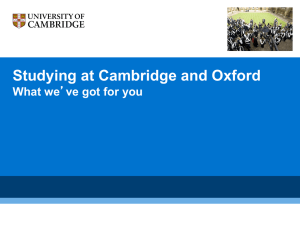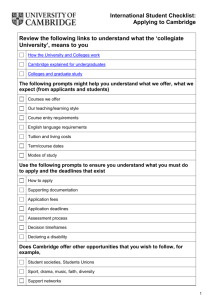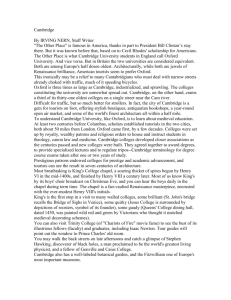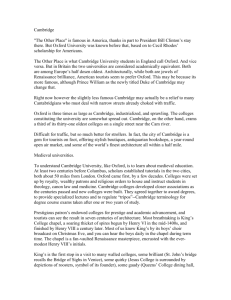View/Open - University of Cambridge
advertisement
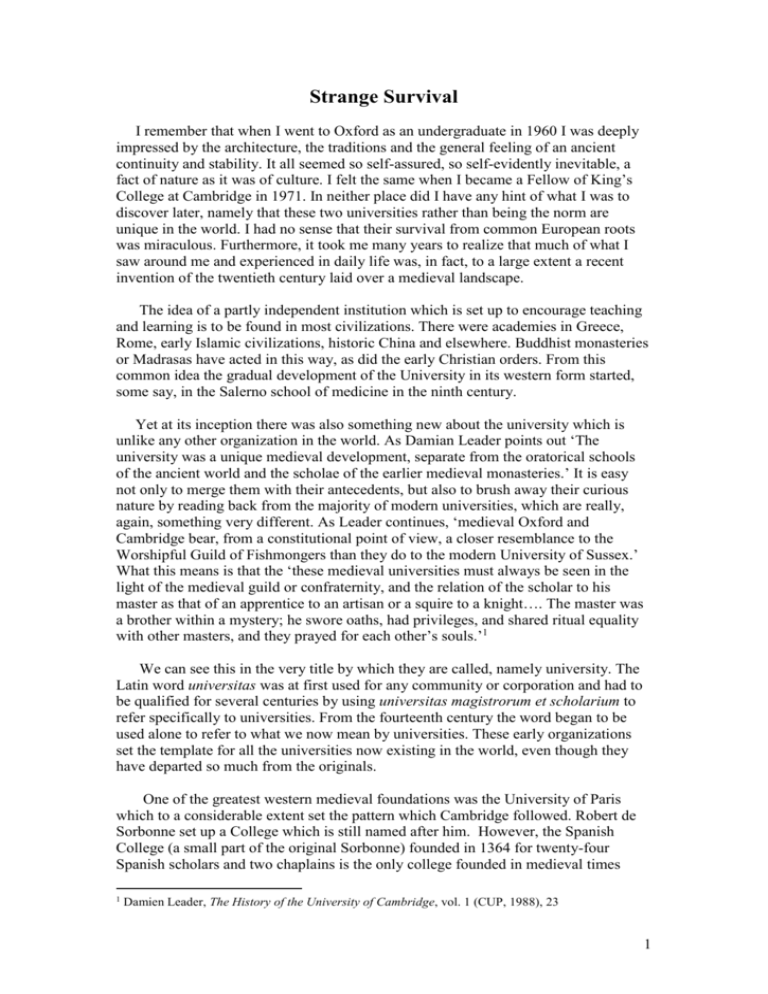
Strange Survival I remember that when I went to Oxford as an undergraduate in 1960 I was deeply impressed by the architecture, the traditions and the general feeling of an ancient continuity and stability. It all seemed so self-assured, so self-evidently inevitable, a fact of nature as it was of culture. I felt the same when I became a Fellow of King’s College at Cambridge in 1971. In neither place did I have any hint of what I was to discover later, namely that these two universities rather than being the norm are unique in the world. I had no sense that their survival from common European roots was miraculous. Furthermore, it took me many years to realize that much of what I saw around me and experienced in daily life was, in fact, to a large extent a recent invention of the twentieth century laid over a medieval landscape. The idea of a partly independent institution which is set up to encourage teaching and learning is to be found in most civilizations. There were academies in Greece, Rome, early Islamic civilizations, historic China and elsewhere. Buddhist monasteries or Madrasas have acted in this way, as did the early Christian orders. From this common idea the gradual development of the University in its western form started, some say, in the Salerno school of medicine in the ninth century. Yet at its inception there was also something new about the university which is unlike any other organization in the world. As Damian Leader points out ‘The university was a unique medieval development, separate from the oratorical schools of the ancient world and the scholae of the earlier medieval monasteries.’ It is easy not only to merge them with their antecedents, but also to brush away their curious nature by reading back from the majority of modern universities, which are really, again, something very different. As Leader continues, ‘medieval Oxford and Cambridge bear, from a constitutional point of view, a closer resemblance to the Worshipful Guild of Fishmongers than they do to the modern University of Sussex.’ What this means is that the ‘these medieval universities must always be seen in the light of the medieval guild or confraternity, and the relation of the scholar to his master as that of an apprentice to an artisan or a squire to a knight…. The master was a brother within a mystery; he swore oaths, had privileges, and shared ritual equality with other masters, and they prayed for each other’s souls.’1 We can see this in the very title by which they are called, namely university. The Latin word universitas was at first used for any community or corporation and had to be qualified for several centuries by using universitas magistrorum et scholarium to refer specifically to universities. From the fourteenth century the word began to be used alone to refer to what we now mean by universities. These early organizations set the template for all the universities now existing in the world, even though they have departed so much from the originals. One of the greatest western medieval foundations was the University of Paris which to a considerable extent set the pattern which Cambridge followed. Robert de Sorbonne set up a College which is still named after him. However, the Spanish College (a small part of the original Sorbonne) founded in 1364 for twenty-four Spanish scholars and two chaplains is the only college founded in medieval times 1 Damien Leader, The History of the University of Cambridge, vol. 1 (CUP, 1988), 23 1 which, according to Denifle, still exists on the Continent.2 Oxford and Cambridge, both dating roughly from the period between 1180 and 1210, followed Paris in establishing small residential halls, sometimes under the direction of a senior teacher, where students could live. European universities tended to be set up in important places, close to the centres of spiritual and secular power. Paris is the quintessential example of this but most continental universities were in big cities where an increasingly powerful Church and State watched their progress with interest. That the two medieval English universities grew up in market towns away from the large cathedrals or biggest cities was strange yet decisive. Innis wrote that ‘In England, law and religion were not fortified by universities since these were not located at the capital or in cathedral cities.’3 The fact that Cambridge was in a rather remote provincial fen town away from London, and with some distance from the cathedrals at Ely and Lincoln, helped it to retain its independence. In turn, that separateness meant that power and knowledge were, to a certain extent, separated – a very different situation to that to be found in almost all other nations and civilizations. Of the two, Cambridge has always been the smaller town. Despite being a few miles closer to London, it still feels remote in its position on the edge of the fens. We may wonder why it was founded in the middle of an inhospitable part of the country and what attracted the scholars who reputedly left Oxford in 1209 to settle there. Cambridge is situated where two major roads intersect, one bringing people and traffic from London the other from Colchester. These roads, Trumpington and Trinity Streets to the west and Regent and Sidney Streets to the east, were built on ancient gravel beds marking an ancient river valley which were the best routes to a river crossing below Castle Hill.4 The earliest records of Cambridge suggest that it was already a quietly prosperous town by the late Anglo-Saxon period and the bridge across the River Cam or Granta, which gave the name to the town had existed since at least 875 A.D.5 By the time of the Domesday survey in 1086 there was a castle on the hill to the north of the bridge and commercial and residential properties along the river as well as several churches in the main settlement. Through the rivers which drained the whole of the east midlands, traders had access to the inland ports and out to the sea. Cambridge was becoming wealthier and there are today eleven surviving medieval parish churches. There were food markets before 1066, and during the twelfth century there were fairs at Garlic Lane, Midsummer Common and Stourbridge. Within or near the town were religious institutions, including the canons who moved to a site in Barnwell, and the Convent of St Radegund which had existed since 1135 and later became incorporated into Jesus College. There were two hospitals and seventeen miles to the north was the great Benedictine house of Ely which after 1109 became the seat of a Bishopric. Enc. Brit, 11th edn., s.v. ‘universities’, 751 Innis, Communication, 21 4 I take this point from Searby, History of Cambridge, 7 5 The following account of early Cambridge is partly based on that on the University website, with kind permission from the University. (for full account see xxx) 2 3 2 * Cambridge University started in a small way. It had no premises of its own and relied on using parish churches, especially Great St Mary’s and St Benedict’s (or Bene’ts) and on the buildings of the religious orders for public ceremonies. Lectures, disputations and lodgings took place in private houses which provided only temporary accommodation. It appears that quite soon groups of what were known as ‘Regent Masters’, that is lawyers and theologians, began to build or hire larger places to teach in or house the students. A few of these privately owned and poorly endowed early hostels survived until the sixteenth century when they were incorporated into the Colleges. By 1226 the University had a Chancellor and regular courses were taught. In around 1250 a complete set of statutes, which have only recently been discovered, were promulgated, pre-dating the first set for Oxford by about fifty years and well before those for Paris or Bologna.6 The form of government which they outline is still recognizable today, though it would constantly evolve and change. From the later fourteenth century onwards, the University began to buy property on the site which is known today as Senate-House hill, and built the ‘Schools’ or ‘Old Schools’ as it is still known. The first building was for the Divinity School, where lectures and disputations took place and there was a chapel, library, treasury and archive. Yet most of Cambridge was still in private hands or belonged to religious houses. From the thirteenth century much was beginning to pass to the new institutions called Colleges, originally for small numbers of advanced students in law or divinity who were to pray for the souls of their benefactors. Later the Colleges began to house the very young undergraduates who had previously lived in hostels or private houses. * By the end of the fifteenth century there were seventy-nine universities in Europe, including two in Scotland. Already, however, the shape and ethos of the two English universities was diverging from elsewhere. The obvious mark of this was the wealth and strength of the Colleges. By 1520 there were in Cambridge thirteen of the thirty-one Colleges that there are today: Peterhouse (1317), Clare (1338), Pembroke (1347), Gonville (1348), Trinity Hall (1350), Corpus Christi (1352), Buckingham College (later Magdalene) (1428), King’s (1441), Queen’s (1446), St. Catharine’s (1473), Jesus (1497), Christ’s (1505) and St. John’s (1511). Although it was still a rather small and peripheral university, with only seven hundred members in the 1370s, rising to 1300 by the 1450s, the Colleges had come a long way from being merely halls of residence. A glimpse into the regime of King’s College in the later fifteenth century shows that they were already a mixture of the social, intellectual and religious, institutions which were almost family-like in their 6 M.B.Hackett, The Original Statutes of Cambridge University (Cambridge, 2008). 3 diversity of functions, yet much larger than a family and mostly based on ties other than blood or marriage. C.R.Fay describes how ‘Daily attendance at the chapel services, daily lectures, beginning at six, a strict routine of study tested by a weekly examination, were the lot of every scholar; and even those of higher standing were bound to many duties. The meals were taken together in the hall, the company listening in silence to the reading of scripture; if they did converse it was in Latin. The College not only boarded and lodged its members, it also clothed them, cut their hair and shaved them. Scholars and fellows were forbidden to sell or pawn their clothes till they had worn them for two years… The College porters trimmed the hair and cut the beards of all the society… No scholar or fellow, chaplain, or clerk, or other officer might keep dogs, ferrets, or hawks, or throw, play, or shoot within or without the College. Moreover, when the scholars went outside the College gates, they were not to go alone or discard their academical dress; and before they could take a walk into the country, leave of the Provost and Dean was necessary.’7 As the Colleges thrived, the University grew more slowly. Indeed, in the extreme case of the very largest foundation of the medieval period, King’s College, the scholars could proceed to their degrees without sitting any University examinations, a feature that remained until 1851. In fact, the University was largely a federation of Colleges. We are told that ‘Before the middle of the sixteenth century, the Colleges began to play a decisive part in University life. They now nominated the Proctors from among their own members for the annual term of office, and their heads often served with the Vice-Chancellor and senior doctors as members of an advisory council which was soon to be called the Caput Senatus. From the sixteenth century until almost the end of the twentieth, the Head of one of the Colleges always held the office of Vice-Chancellor.’8 In a certain sense, there was no unified and centralized University of Cambridge until at least the end of the nineteenth century. This was very different from what happened on the Continent and Scotland. There the Universities grew more powerful and the Colleges failed to develop independent wealth through rich endowments or the capacity to teach. The fledgling medieval collegiate systems withered away so that by the end of the eighteenth century only Oxford and Cambridge retained a strong set of independent institutions within a federal structure. The difficulty of transferring the Oxbridge system elsewhere is shown by the experiment in America. As Norman Scarfe points out, ‘of the 130 University men who migrated across the North Atlantic before 1646, 100 were from Cambridge and no fewer than 35 from Emmanuel, easily the biggest, most influential contingent at work on the mind of New England. They included John Cotton, the leading divine of Massachusetts, and John Harvard…’ 9 We would therefore expect that Harvard above all would have a Collegiate structure, later to be imitated by other Ivy League Colleges. Yet although the American universities were called Colleges for some centuries, each being set up by a different denomination, they did not continue or 7 8 9 Fay, King’s College, 54-5 Univ. website, history Scarfe, Cambridgeshire, 93-4 4 incorporate the Oxbridge College system. Harvard and others do have various associations and clubs, fraternities and sororities, and various social arrangements based on halls of residence, but the University was strong and no real alternative centres of wealth or teaching were set up. So there is no Oxbridge equivalent in America today, just as the universities set up in India, Canada and Australia in the nineteenth century, at the height of the British Empire, have not replicated the system. Nor have the wave of new universities in the emerging east Asian civilizations, in Korea, Japan or China, for example, much as they owe inspiration to parts of the European tradition, established anything like the collegiate system. Even within Britain, the experiment could not be replicated. The early Scottish universities lost their Collegiate structure in the sixteenth and seventeenth centuries and now have them only in name or as residential halls. Trinity College, Dublin, which was set up on the Cambridge model and whose leaders were Cambridge men for some time, never really developed a Collegiate model. In some ways the most interesting case is the University of Durham. Oliver Cromwell wanted to set up a University in Durham, but failed. It was set up as the first new English University by Act of Parliament in 1832 and granted a Royal Charter in 1837. It has Colleges, but they are not self-governing and independent in the same way as those in Oxbridge, nor do they have the corporate property or much of the teaching role of such Colleges. In general they are responsible for the social welfare of the students. Later universities in England, the ‘red brick’ universities of Victorian England such as Manchester, Liverpool and London, and the ‘plate glass’ universities of the 1960’s, such as Kent, Sussex or Lancaster, do not have much beyond halls of residence. * It was not just the Collegiate system that diverged. There were many notable universities in medieval Europe. A number of them, such as Bologna and Paris, were older and more distinguished than Cambridge. Yet almost all the great medieval universities were seriously weakened or largely destroyed in the period between the fifteenth and eighteenth centuries. In Italy, Portugal, Spain, France and Germany by the end of the period they had lost much of their independence. Royal power, often in league with religious authority, was jealous of the intellectual autonomy and wealth of the old universities. The centralizing absolutisms increasingly undermined them, absorbing their wealth and crushing their independence. For example, in Germany, at the Reformation in the sixteenth century, the universities became ‘instruments of the states… their traditional autonomy and freedom disappeared; the professors became state employees; censorship and strict discipline were imposed. The university was regarded as an institution to train functionaries for the state and for the national church attached to it.’10 10 Enc. Social Sciences, 1935, 182 5 The once independent University of Paris became embroiled in the religious wars of the later sixteenth century and this, along with the growing power of the French monarchy in the seventeenth and eighteenth century meant that it gradually fell under the direct control of the Crown. The final blow to an already largely emasculated university occurred in 1793 when the revolutionary authorities abolished all of the French universities. When they were revived in 1808 by Napoleon, they were explicitly State institutions, governed by officials. French academics to this day are civil servants. Little independence either of the University or their constituent Colleges is envisaged in this centralized system. The French universities were not the only ones to disappear. Many of the German universities, including Mainz, Cologne, Bamberg, Salzburg and Erfurt were closed between 1798 and 1815. This is a widespread tendency and it is not confined to Europe. If we look at the history of independent intellectual institutions throughout the world, whether in the Islamic civilizations of the near East and India, or the Confucian and neo-Confucian worlds of China and Japan, we find that everywhere early shoots of independence and freedom of enquiry were destroyed. By the eighteenth century there was nothing like a free university anywhere outside north Western Europe and North America. The story of Cambridge (and Oxford) is the exception. Somehow it carried the alternative vision of independent centres of power and knowledge through to the present in a continuous eight hundred year arc. This is its greatest achievement, but it was a close thing. Once it was almost totally destroyed, and several times after that nearly trimmed away into mediocrity. Yet in each case a combination of luck, political connections and the broader context of an unusually dispersed system of countervailing powers helped it to avoid destruction. Subsequently, in the reforms of the universities in the later nineteenth century and nowadays under constant governmental financial and organizational pressures, the universities have had to trim their aspirations. Yet in 1660 after Charles II confirmed the charters granted by his predecessors, Cambridge University was never again under dire threat of being abolished. Throughout the eighteenth and nineteenth centuries many important political figures were educated at Cambridge, including several members of the royal family and leading prime ministers like Walpole and Pitt the Younger. So the threat of total destruction of the autonomous power and privileges of the university was over, although, as we shall see, it is still vulnerable. * We can break an answer to the question of the continuous survival and flourishing of this ancient university into several parts. One relates to the internal governance of the University and its ability to change and adapt with the times. I shall consider this ability in the next chapter. Here I want to look at the wider context within which Cambridge operated. A society or civilization to a certain extent gets the university it deserves. If a society is open, balanced and liberal, it will be reflected in that kind of university. If it is closed, inquisitorial, centralized, it will get another kind. The fact that universities are mirrors of civilizational histories is another reason for writing about Cambridge. In order really to understand Cambridge, we need to know a good deal about the 6 shape of English history from the thirteenth century onwards, and particularly during its formative period up to the seventeenth century. Cambridge was shaped by a particular intersection of law, politics, economics and religion, parts of which will be touched on in later chapters. Within law, the unique nature of trusts and corporations in English law seems the central determinant. This in turn was connected to a particular distribution of power whereby the Crown could not absorb or undermine the independence of rich and powerful institutions dedicated to education. This in turn was partly based on their economic independence through endowments. All this was later held within the context of an Anglican religious settlement whereby the power of the Church was again limited in a way that was not true of resurgent Catholicism on the Continent, or Calvinism in Scotland. Within this delicate interplay of forces, the crucial time which could have seen the end of the experiment, but instead saw its flourishing, was between about 1500 and 1800. It was in that period that the wealth and independence of the University of Cambridge and its Colleges was firmly established. Yet it was also the period of the greatest potential threat to its independence. * The individual and precarious factors through Cambridge history, the ‘chaos theory’ part of the story where the absence of just one person might have led to a different outcome, can be shown in a few of the characteristic moments when the wealth and power of the Colleges was nearly destroyed. If this had happened, Cambridge would now be very different. The first and greatest threat to Cambridge occurred in the last years of Henry VIII. Elizabeth Leedham-Green tells the story and I shall take my account from her.11 In the 1530s and 1540s the Crown was busily suppressing the monasteries and appropriating their wealth. The University and Colleges were first visited by Thomas Cromwell’s deputy, Thomas Leigh, ‘a graduate of King’s and notorious as a suppressor of monasteries’ in 1535 and were ordered to deliver their ‘papistical muniments’ with details of all their other wealth. They did this. This was just a prelude, for the colleges of the university ‘were also seen as religious houses, and the vultures looked at them with interest.’ The situation reached a crisis in the mid 1540’s. ‘In 1545 an Act was passed for the dissolution of all major chantries and all colleges, placing all the foundations in the university at the king’s disposal. This was the threat to end all threats. By now the colleges were the university…’ Leedham-Green explains that ‘The precise means by which the universities snatched themselves from ruin remain obscure, but their defence was conducted on three fronts.’ Firstly, the king was ‘persuaded to save the expense of sending expert surveyors down from London by appointing rather men already in place’. Secondly they appealed successfully to Queen Katherine Parr, whose support was probably gained by Thomas Smith and John Cheke, both royal tutors. ‘Both had had the same teacher there, John Redman, and it is mainly to him, most probably, that the university owes its survival of this crisis.’ 11 See L-Green, pp. 47-50 7 College bursars probably made the surveys of college lands and income. The King remarked on seeing their returns that ‘he thought he had not in his realm so many persons so honestly maintained in living by so little land and rent’. Questions were raised as to how the Colleges lived in a permanent state of deficit ‘to which the reply was made, truthfully if economically, that it was done by the levying of fines on the renewal of leases in those years in which they fell due and by sales of wood.’ The third line of defence ‘is obscure in its mechanism but visually pre-eminent in its results’. It seems to have consisted in appealing to Henry’s vanity, or fear for his soul, so that instead of abolishing the colleges, he added to their glory. Henry was persuaded to re-establish a languishing foundation of Wolsey’s as Henry VIII College (later Christ Church, Oxford). John Redman pointed out that the same effect could be achieved at Cambridge by absorbing three older foundations into one which became Trinity College, and he even found funds for completing Henry VI’s lavish chapel at King’s. As Leedham-Green remarks, ‘The situation had been saved, and the university as an institution was perhaps never again to face so grave a threat’. The accession of Edward VI in 1548 was hailed by the Protestant party, very strong in Cambridge, and the universities were expressly omitted from the Act for dissolving chantries. That the tradition of intellectual independence should have been saved by the machinations of a handful of well-placed individuals is a good example of how great effects can depend on small causes. It was to happen again in 1997/8 when two or three key individuals, including Roy Jenkins and Tony Blair’s old schoolmaster from Fettes, by then Rector of Lincoln College, Oxford, reputedly saved the Colleges from a crippling loss of their tuition fees which might have destroyed the central purpose of a Collegiate university.12 The second threat was not on this scale, though it would have seriously weakened the independence of the university if it had not been averted. It occurred when Archbishop Laud was in power in the 1630’s. He insisted on his right to visit the universities as Archbishop of Canterbury, to which they objected. ‘Cambridge was asked to search its muniments for any privilege exempting them from metropolitical jurisdiction.’ Although the University tried to assert its privilege, the King rejected this and it looked as if the visitation would take place. But ‘miraculously the threat never materialised, “for”, as Laud was to recall, “my Troubles began then to be foreseen by me, and I visited them not”’.13 The third occasion was during the Civil Wars and Interregnum in the middle of the seventeenth century. At the minimum it could have meant the destruction of some of the finest medieval stained glass in the world. In 1644 William Dowsing, Parliament’s agent in the eastern counties, was sent to Cambridge to undertake ‘the utter demolishing, removing and taking away of all Monument of Superstition or Idolatry’. Pictures and statues were destroyed, chancels were levelled and other trappings smashed. But for reasons unknown, the great windows at King’s College were spared. 12 13 For an account of some of the events, see Annan, The Dons, 299-301 L-Green, 70-1 8 Later the parliamentary general, the Earl of Manchester, descended on the university and various heads of Colleges were removed for refusal to take the Solemn League and Covenant and for other reasons.14 But basically the University was too well entrenched to suffer more than superficial damage from such activities. Less well known, however, was a threat emanating from within. Leedham Green draws attention to the call by the Master of Caius College, William Dell, who had argued against the system of traditional studies, and indeed the very notion of degrees. But she says that he and others ‘did not seem to deduce from these premises any necessary diminution in the status of the universities’.15 She does not refer to something described as follows: ‘It was even proposed by William Dell – himself the master of Caius College – to abolish the two universities altogether, as hopelessly pledged to antiquated and obsolete methods, and to establish in their place schools for the higher instruction throughout the country. They were saved, however, by the firmness of Cromwell, at that time chancellor of Oxford…’16 * Given these accidents and divergences we can see that nothing was inevitable. Saved by a number of curious chances, the University of Cambridge and its Colleges in particular evolved over the centuries. In the first part of the sixteenth century, King’s College Chapel was completed and the grand new College of Trinity was added in 1546; Dr Caius enlarged Gonville Hall to make it almost a new foundation, called Gonville and Caius College (1557); Emmanuel (1548) absorbed the Dominican site, Sidney Sussex (1594) that of the Franciscans, and Magdalene absorbed the former Benedictine house of studies known as Buckingham College. These new foundations were concerned with the education of men for the priesthood in the national church, but they, and Trinity especially, attracted for the first time large numbers of lay students. The University saw another phase of College expansion in the later nineteenth century. The numbers of students doubled between 1850 and 1910 and Colleges started to appoint teaching fellows, who replaced the private tutors. The supervision system as we know it today was inaugurated. The dons were permitted to marry and retain their fellowships. The science faculties began to emerge on what had previously been the botanical garden off Downing Street. There was also the establishment at Cambridge of two Colleges for women students (Girton in 1869 and Newnham in 1872). From the beginning, these Colleges aimed to prepare their students for the Tripos, and the first women were in fact examined in 1882, although attempts to make women full members of the University were repeatedly defeated until 1947. By 1900, of some twenty thousand university students in Britain about one third were at Oxford or Cambridge. They were still the dominant universities in a way in which they are no longer as they now represent well under five percent of the student population in British universities. Yet their relative shrinkage was not an absolute 14 L-Green, 81-3 L-Green, 91 16 Enc. Brit., 11th edn., 771. This story will need to be checked with L-Green. 15 9 decline. The twentieth century has been Cambridge’s greatest century in terms of intellectual and artistic contribution to the national life. The story from 1900 to the present is best told in a different way. This will explain some of the strange survival of archaic features that has been the theme of this chapter. 10
